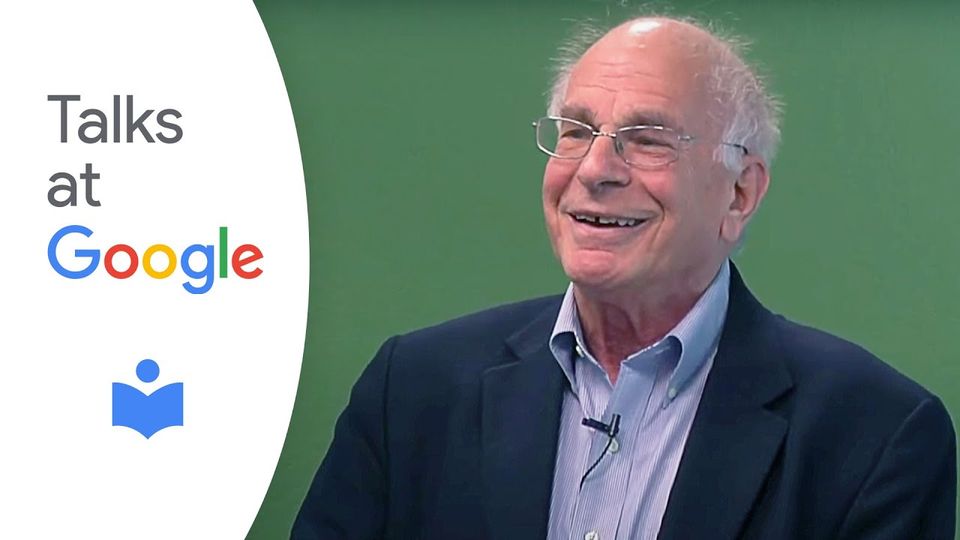Thinking, Fast and Slow: Daniel Kahneman at Talks at Google | Summary and Q&A

Summary:
In his talk, Daniel Kahneman discusses the two systems of thinking - System 1 which is fast, intuitive, and automatic, and System 2 which is slower, deliberative, and effortful. He explains how System 1 relies on associative memory and is prone to biases, heuristics, and substitutions that can lead to intuitive errors. System 2 can override System 1, but takes effort. Kahneman discusses experiments that demonstrate these two systems and how they shape our judgment and decision-making.
- System 1 thinking is fast, automatic, and effortless. It relies on shortcuts and associations. System 2 thinking is slower, more deliberate, and effortful.
- Intuition depends on the environment. In a regular world with good feedback, experts can develop good intuitive judgement. But intuition fails in less predictable environments.
- Confidence is a feeling, not a judgement. It comes from the coherence of the story System 1 generates, not the quality of information. High confidence can be mistaken.
- System 1 often answers easier questions than the one asked, substituting intuitive responses that feel right but may be wrong. This can lead to biases.
- Understanding the "personalities" of System 1 and System 2, even though they don't literally exist, can help us think better about our intuitive and reasoning processes.
Questions and Answers:
Q: Can you explain more about the characteristics of System 1 thinking?
A: System 1 thinking is fast, intuitive, automatic, and effortless. It happens spontaneously without us being aware of it. For example, we read words automatically without deciding to read them. System 1 relies heavily on associative memory - a network of connected ideas and concepts. When we encounter a stimulus, it activates part of this network, spreading activation to related concepts. This prepares us to recognize related things faster. An example is reading emotional words - it activates related concepts so we detect those faster. System 1 thinking includes our perceptions, intuitions, and skilled actions that have become automatic through practice. It constantly generates impressions, intuitions, and feelings that shape our judgment.
Q: What are some of the downsides or limitations of System 1 thinking?
A: While System 1 is fast and efficient, it is prone to biases, heuristics, and errors. For example, it tends to make causal attributions even when there is no true causal link - like linking bananas and vomit in a meaningless phrase. It also relies heavily on substitution - answering an easier question than the one asked, which can lead to mistakes. Things like the bat and ball problem illustrate this. System 1 goes for easy coherence rather than correctness. It is also overly influenced by emotions, vivid stimuli, and associations from memory. First impressions generated by System 1 are often wrong. But we tend to have high confidence in them. Overall, System 1 thinking, while useful, can lead to irrational judgment if not kept in check.
Q: How does System 2 thinking work and how is it different from System 1?
A: System 2 thinking is slower, deliberate, effortful and controlled. It is engaged when we encounter surprise or need to pay close attention. An example is working through a math problem step-by-step. This requires focus, keeping steps in memory, and effort. We experience System 2 thinking as something we consciously do, rather than impressions that just happen to us. Brain imaging shows different activation patterns for System 1 versus 2. System 2 can override intuitions and impressions generated by System 1. But System 2 is also constrained - it can only work with the information and knowledge we have. Both systems are fallible in different ways. System 2 takes effort and can get depleted if we exert too much self-control.
Q: How do these two systems interact and shape judgment and decision making?
A: In many situations, System 1 generates intuitive judgments which System 2 then endorses or overrides. Errors can occur when System 1 substitutions or biases go uncorrected. For example, the bat and ball problem - System 1 intuitions are often wrong but feel right, unless System 2 deliberatively checks them. Skilled decision makers need to recognize situations where intuitions shouldn't be trusted. Training can help calibrate System 1 associations in environments with stable rules. But it is hard to improve System 1 itself - it will generate impressions and feelings automatically. The best approach is to train System 2 to recognize contexts where biases are likely, consciously override intuitions, and engage in deliberative thinking. But this takes substantial mental effort. Overall, the two systems interact to shape judgment and choice - ideally complementing each other.
Q: How does subjective confidence relate to the two systems and sound judgment?
A: Subjective confidence arises from System 1 and reflects the coherence or fluency of the intuitive story it has generated - not actual accuracy. High coherence can occur even with little evidence. This means confidence is often miscalibrated with reality and is not a reliable indicator of judgment quality. Confidence comes more from the quality of the story than the quality of the information. So we often have unwarranted confidence in intuitions and impressions generated by System 1. The soundness of a judgment depends more on the environment someone has operated in and their opportunity to learn, rather than their confidence. Misplaced overconfidence is common and problematic. System 2 reasoning is better for assessing confidence calibration.
Q: How do the two systems apply in areas like medical diagnosis?
A: Medical diagnosis involves pattern recognition, which relies heavily on System 1 intuition developed from clinical experience. However, physicians also need System 2 analysis. For example, when diagnosing a complex case, a doctor should deliberately analyze symptoms, test results, and alternate explanations, not just rely on the initial intuition. Pure pattern-matching can lead to cognitive biases. Experienced doctors may recognize when additional deliberative thinking is needed to override intuitive errors. The ideal is complimentary System 1 pattern recognition and System 2 analytical thinking. This allows doctors to benefit from expertise while avoiding mistakes.
Q: What kinds of jobs or professions tend to rely more on one system versus the other?
A: Jobs that involve complex physical skills or pattern recognition tend to rely heavily on intuitive System 1 thinking that has been honed through extensive practice. This includes professions like professional athletes, dancers, pilots, drivers, artists, musicians, and advanced tradespeople. Professions that require intensive logical analysis, computation, and careful judgment independent of intuition rely more on deliberate System 2 thinking. This includes scientists, engineers, accountants, logicians, and academics. However, most jobs involve a combination of the two systems. For example, while physicians rely on System 1 intuition, they also need System 2 analysis. Good decision makers use both systems effectively.
Q: How do the two systems relate to personality traits? Are some people more prone to one system or the other?
A: There is some evidence that certain personality traits correlate with reliance on the two systems. For example, people higher in openness may be more analytical and reflective, using more System 2 thinking. Conscientious people may have more self-control to override System 1 impulses. Extroverts may be more influenced by emotional stimuli that activate System 1. However, most personality likely involves both systems. An exception is that some people seem to have more active System 2 control, which relates to conscientiousness. Overall, balance is ideal. Being too dependent on one system versus the other can be detrimental in different ways. Training System 2 to recognize flaws in System 1 thinking is useful for anyone.
Q: How might issues like cognitive decline affect the two systems and decision quality?
A: Cognitive decline appears to impair both systems, but can damage executive control functions more severely. This makes overriding errors from System 1 failures more difficult. However, experience and expertise built into System 1 may remain intact longer, allowing older adults to benefit from accumulated intuitive wisdom. The downside is that when System 1 intuition is wrong, they may have trouble deliberatively correcting course using System 2 reasoning. Boosting System 2 functions with cognitive training may help older adults retain decision-making abilities longer. Effortful thinking and attention control decline, but practiced intuitions still contribute to judgment when calibrated properly against System 2 oversight.
Q: What advice would you give for training System 2 to work better with System 1?
A: First, recognize that effortful analytical thinking is limited, so conserve it for important judgments. Don't waste cognitive resources deliberating over minor choices. Next, identify contexts prone to known System 1 biases and make a habit of deliberative System 2 checking in those situations. These include choices influenced by emotion, recent events, or distortions like substitution heuristics and social biases. Practice overriding impulses and intuitions in safe contexts to build self-control. Seek objective data to correct perceptions shaped by System 1 impressions. Consider opposite views to break confirmation bias. And allow time for decisions when possible - intuition increases with time pressure. The key is recognizing when to deploy additional System 2 thinking to counteract predictable System 1 pitfalls.
Takeaways:
In closing, Kahneman's talk on the two systems of thinking provides a fascinating insight into the complex machinery of the human mind. While System 1 and System 2 may be useful fictions, understanding their different characteristics can help us recognize the strengths and weaknesses of our intuitive and analytical processes. Learning when to trust versus doubt our intuitions, and how to educate System 2 to catch biases, can lead to better judgement and decision making. Though our minds are prone to illusions, being aware of the "personalities" of System 1 and System 2 moves us a step closer to thinking more clearly.
Books:
- Thinking, Fast and Slow by Daniel Kahneman - The book this talk is based on, explaining System 1 and System 2 in detail.
- Nudge: Improving Decisions About Health, Wealth, and Happiness by Richard Thaler and Cass Sunstein - Looks at how nudges and choice architecture can influence System 1 thinking.
- Blink: The Power of Thinking Without Thinking by Malcolm Gladwell - Discusses the power of intuitive snap judgements, for good and bad.
- Sources of Power: How People Make Decisions by Gary Klein - Explores the value of expertise and intuition in decision-making.
Articles:
- Khatri, N., & Ng, H. A. (2000). The Role of Intuition in Strategic Decision Making. Human Relations, 53(1), 57–86. https://doi.org/10.1177/0018726700531004
- Hodgkinson, G.P., Langan-Fox, J., & Sadler-Smith, E. (2010). Intuition: A fundamental bridging construct in the behavioural sciences. https://doi.org/10.1348/000712607X216666
Concepts:
- Dual process theory - The theory that two distinct processing modes underlie thinking and judgement.
- Heuristics and biases - Mental shortcuts that can lead to systematic errors and cognitive biases.
- Naturalistic decision making - Research on how people use intuition and expertise to make decisions in real-world contexts.
